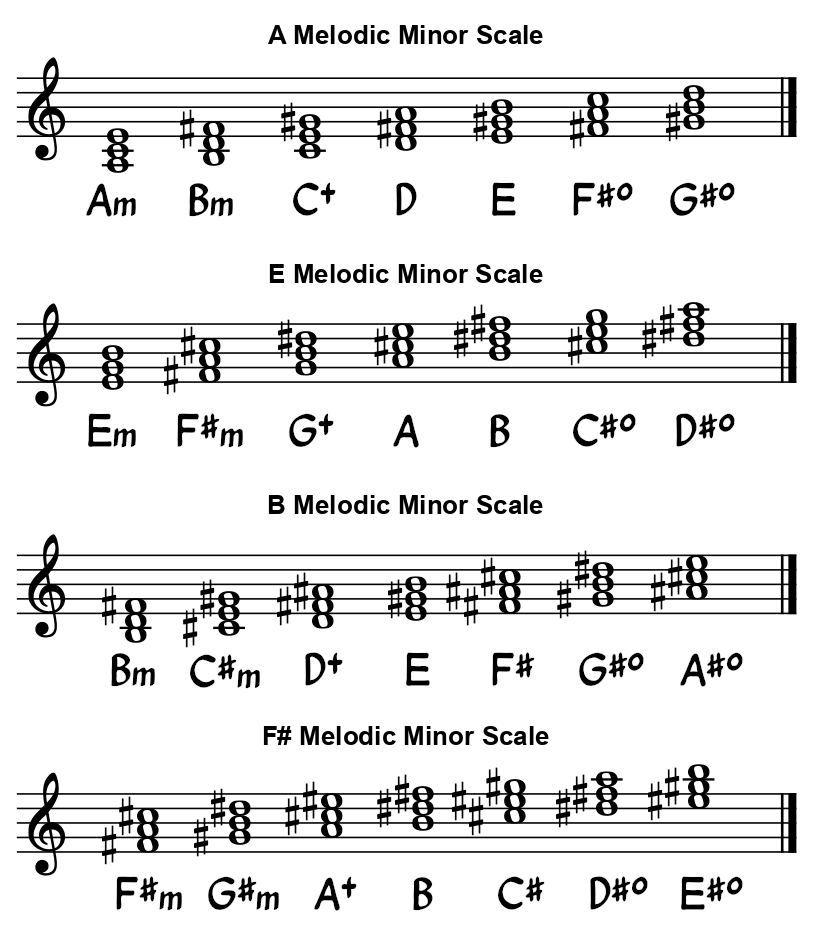The process of harmonizing a scale involves building chords on each degree (note) of the scale, using only notes from that scale.
This post will:
- Take us through the process of harmonizing the melodic minor scale with triads.
- Analyze the chords that result, along with the Roman numerals assigned to each chord.
- Show the relationship between the chords in a harmonized melodic minor scale and the scale itself.
- Provide instruction on how that relationship relates to soloing on a guitar.
Harmonizing the Melodic Minor Scale
The melodic minor scale is identical to the major scale except for the flatted third scale degree in the melodic minor scale.
So instead of harmonizing the melodic minor scale from scratch, we will use the harmonized major scale as our starting point, and then alter the third scale degree in the chords that contain that note.
Harmonized A Major Scale
Fig.1 shows a harmonized A major scale.
Fig.1

Harmonized A Melodic Minor Scale
The only difference between an A major scale and an A melodic minor scale is that an A major scale contains a C# and an A melodic minor scale contains a C natural instead (fig.2).
Fig.2


So to create a harmonized A melodic minor scale from a harmonized A major scale, we need to change all of the C#’s in the harmonized major scale to C naturals in the harmonized melodic minor scale in the chords that contain that note.
Fig.3 shows a harmonized A melodic minor scale with the changed notes highlighted in blue.
Fig.3

Diatonic Chords: Triads
The flatted third scale degree (C) in an A melodic minor scale is included in three of the chords in the harmonized scale — the i, bIII+ and vi° chords .
Consequently, the qualities of those chords change from what they were in a harmonized A major scale, where the third scale degree was C#:
- The i chord is minor.
- The bIII+ chord is augmented.
- The vi° chord is diminished.
The other four chords remain unchanged.
Roman Numerals
Every melodic minor scale has seven triads that are diatonic to it, one chord for each scale degree.
And each of the seven diatonic chords is assigned a Roman numeral, which reflects the chord’s position within the key, relative to the tonal center (the first note or chord).
Fig.4 shows the Roman numerals representing the triads diatonic to an A melodic minor scale.
Fig.4

Sequence of Chords
Every harmonized melodic minor scale has the same sequence of chords. As the sequence of chord qualities is the same in every key, the sequence of Roman numerals is also identical.
In any given melodic minor scale:
- The i and ii chords are minor.
- The bIII+ chord is augmented.
- The IV and V chords are major.
- The vi° and vii° chords are diminished.
All 12 Harmonized Melodic Minor Scales
Fig.5 shows all 12 harmonized melodic minor scales.
Fig.5



Soloing Application
In general, you can use a melodic minor scale to solo over any of the chords that are diatonic to it because the notes generally won’t clash with the chords.
For more specific soloing applications for the melodic minor scale, see the post entitled Modes of the Melodic Minor Scale III.
Related Posts
Related posts include:
